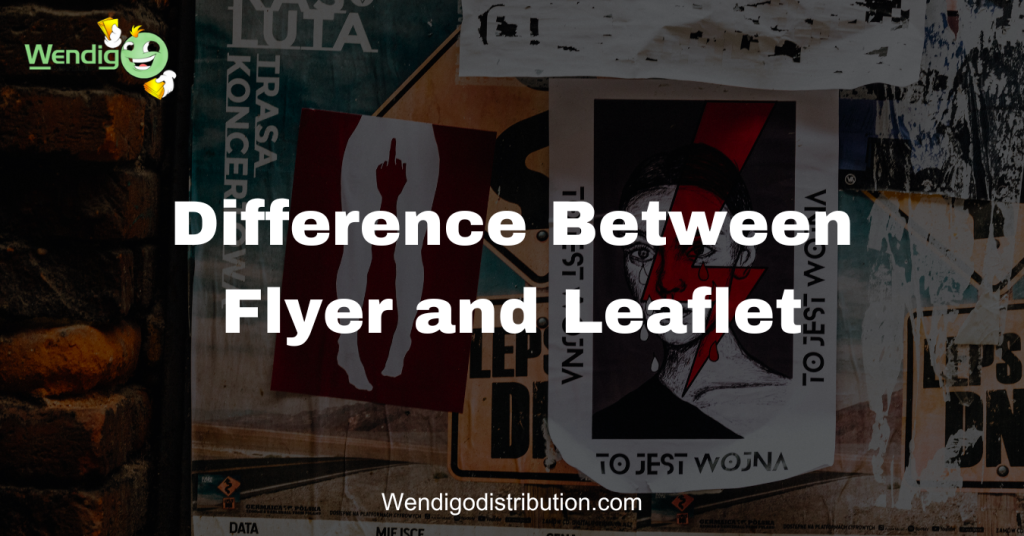As a business owner or marketer, you understand Difference Between Flyer and Leaflet. Two common ways to spread the word about your company, product, or service are flyers and leaflets. However, many use these terms interchangeably without realizing there are differences between these printed materials. Knowing how to distinguish between flyers and leaflets can help ensure you choose the option that will be most effective for your needs.
Both can be useful for promotion and outreach but have distinct characteristics in terms of content, design, distribution method, and purpose. Read on to gain a clear understanding of flyers versus leaflets so you can leverage the strengths of each for your marketing efforts. With the right approach, you’ll be on your way to boosting awareness and sales through the strategic use of print media.

Size Matters: Comparing the Dimensions of Flyers and Leaflets
When determining whether a marketing collateral piece qualifies as a flyer or leaflet, size is an important distinguishing factor to consider.
Flyers are typically larger, often 8.5 inches by 11 inches (the size of a standard sheet of paper) or larger. Leaflets, on the other hand, are usually smaller, around 4 inches by 6 inches to 5 inches by 7 inches. The smaller size of leaflets makes them ideal for direct mail campaigns where postage costs are a concern or for handing out in person. The larger size of flyers allows for more content and visuals, so they tend to be better suited for promoting events, sales, or new products and services.
In addition to physical size, the amount of information included can also help differentiate between flyers and leaflets. Flyers usually provide more details, including images, and often advertise a single event, product, or service. Leaflets, due to their compact size, typically contain less content and cover more general information or an overview of a company and its offerings.
While flyers and leaflets share some similar characteristics and purposes, understanding the distinctions in their size, content, and usage can help guide you in selecting the most appropriate option for your next print marketing campaign. Whether you need an eye-catching flyer to spread the word about an upcoming event or small but informative leaflets to distribute to potential new customers, choosing the right format and content will maximize your reach and results.
Paper Stock: Glossy Flyers vs Basic Leaflets
When determining whether to use a flyer or leaflet for your marketing campaign, an important factor to consider is the paper stock. Flyers are typically printed on glossy or semi-gloss paper to create an eye-catching effect, while leaflets tend to use more basic, matte paper.
Glossy flyers, with their sleek and polished finish, are designed to grab attention. The coated paper allows for higher quality, colorful images and graphics that pop. This makes flyers ideal for promoting a new product launch or service. The glossy sheen also gives the perception of a more premium and professional feel. However, glossy flyers tend to be more expensive to produce compared to leaflets.
In contrast, leaflets are printed on uncoated paper stock that has a dull, matte finish. While leaflets can still include images and logos, the print quality may appear less vibrant. The plain paper gives leaflets a more simplistic look and feel. Due to lower production costs, leaflets are well-suited for non-profits organizations or small businesses on a budget. The straightforward design also lends itself better to conveying information about community events, political platforms or public health initiatives.
In summary, the choice between flyers and leaflets depends on your marketing objectives and budget. For an eye-catching promotional campaign where image is important, glossy flyers are ideal despite higher costs. If your goal is to educate or spread awareness about a cause or issue, basic leaflets will serve your needs at a lower price point. Selecting the appropriate paper stock is a key consideration when determining which print medium is right for your organization or business.
Getting Your Message Across: Content and Design Differences
To effectively convey your message, it’s important to understand the differences between flyers and leaflets in both content and design.
Content
Flyers are typically promotional, advertising an event, product, or service, whereas leaflets aim to inform or educate the reader on a specific topic. Flyers have a commercial focus, while leaflets have an informative focus.
- Flyers use attention-grabbing headlines and vibrant language to sell or persuade the audience. Leaflets employ an objective, factual tone to disseminate details about a subject.
- Flyers highlight benefits and special offers. Leaflets provide an overview of a complex issue or instructions on how to do something.
- Flyers have a call-to-action, encouraging the reader to buy, sign up or attend. Leaflets have no hard sell and simply share information.
Design
The design and layout also differ significantly between these print materials.
- Flyers make heavy use of images, color, and eye-catching graphics to capture interest, whereas leaflets primarily use text with minimal images.
- Flyers have a cluttered, busy appearance with lots going on. Leaflets have a simple, minimalist style with plenty of white space for easy reading.
- Flyers are typically printed on glossy paper. Leaflets use standard copy paper to keep costs down.
In summary, while flyers and leaflets are both useful for spreading a message, understanding how they differ in content, tone, and design will help you choose the right medium for your needs and ensure you achieve the optimal results in effectively communicating with your target audience. Selecting the appropriate option—a flyer to promote or a leaflet to inform—and then optimizing its content and layout for that specific purpose is key.
Distribution Differences: Targeting Your Audience
Distribution Location
The location where you distribute your materials is key to reaching your target audience. Flyers are best for targeted local distribution, while leaflets have a wider distribution range.
Flyers should be distributed in areas where your specific audience frequents. For example, if promoting an event to students, distribute flyers on a university campus. If advertising a new product to homeowners, leave flyers in residential mailboxes or on front doors in a neighborhood. The focused, localized distribution of flyers increases the likelihood of them reaching interested individuals.
In contrast, leaflets have a much wider distribution and are meant to reach a broader range of people over a larger geographical area. Leaflets are often distributed in commercial areas with heavy foot traffic, such as shopping districts, downtown city centers, and transportation hubs like bus stops or train platforms. The wider net cast by leaflets means more people will receive the information, though not all may be genuinely interested or impacted. The broad distribution can also lead to higher waste if many of the leaflets are discarded unread.
Content and Design
The content, visuals, and design of your materials should match the distribution method. Flyers often have targeted messaging aimed at a specific audience with customized images and logos. A leaflet usually has more general information to appeal to a diverse range of people.
In summary, the location and scope of distribution are key distinguishing factors between flyers and leaflets. Flyers have a localized, focused distribution targeting select groups, while leaflets have a wide distribution over a large area to reach more general audiences. The content and design of each should match the distribution to optimize the impact. Carefully consider your goals and audience to determine whether a flyer, leaflet, or perhaps digital distribution is the best promotional tool for your message.
Cost Considerations: The Price Points of Flyers and Leaflets
When creating marketing materials like flyers and leaflets, cost is an important consideration for any business. Flyers and leaflets have varying price points based on several factors.
Paper Stock
The type of paper used has a significant impact on overall cost. Flyers are often printed on less expensive paper, such as matte stock or uncoated paper. Leaflets typically use a thicker, glossier paper for a more premium feel. Glossy or coated paper is more expensive but also more durable and visually appealing.
Size
Flyers are usually smaller in size, around 5 by 7 inches or 8 by 10 inches, while leaflets are often a bit larger, around 8 by 11 inches or 11 by 17 inches. Larger sizes require more paper and ink, so they cost more to produce.
Number of Pages
Flyers are typically only one page, though some are two-sided. Leaflets usually contain multiple panels and pages to provide more in-depth information. Additional pages add to the total cost.
Color Printing
Color printing is more expensive than standard black and white. Flyers often use spot color or limited color accents to keep costs down, while leaflets frequently use full-color printing on both sides for maximum visual impact. Full-color leaflets can cost two to five times more than black and white flyers.
Finishing Options
Professional finishing like UV glossy coating, die-cutting, embossing or foil stamping significantly increase the price of any print marketing piece. These premium finishes are more commonly used for leaflets to convey a polished, high-quality impression. Simple trimming and folding are typically the only finishes for a standard flyer.
In summary, while the specific cost for your flyers or leaflets will depend on the details of your particular project, leaflets are usually significantly more expensive than flyers due to differences in paper, size, length, color printing and finishing options. Consider your budget and the impression you want to make to determine which option is right for your needs.
Conclusion
In summary, while flyers and leaflets are similar in their aim to distribute information to a target audience, there are some key differences to keep in mind. A flyer tends to be more temporary, focused on a specific event or promotion, while a leaflet provides longer-lasting information. Flyers also typically have more visuals and graphics to quickly grab attention, whereas leaflets rely more on written content to inform and persuade readers.
When planning your next marketing campaign, think carefully about your goals and audience to determine whether a flyer or leaflet will be the more effective tool for your needs. With a clear understanding of the distinctions between these two print materials, you can leverage them strategically to achieve maximum impact.
People Also Asked About Difference Between Flyer and Leaflet
Q: What is the difference between a flyer and a leaflet?
A: A flyer and a leaflet are both printed promotional materials, but they differ in certain aspects.
Q: How do flyers and leaflets differ in terms of size?
A: Flyers are typically larger in size compared to leaflets. They are commonly printed on standard letter-sized paper (8.5 x 11 inches) or A4 size (8.27 x 11.69 inches). On the other hand, leaflets are usually smaller and can come in various sizes, such as A5 (5.83 x 8.27 inches) or DL (8.27 x 3.94 inches).
Q: What are the design and layout differences between flyers and leaflets?
A: Flyers generally have a more visually striking design, utilizing vivid colors, bold fonts, and eye-catching graphics to grab the reader’s attention. They often feature a single page with a prominent central message. In contrast, leaflets tend to have a more informative layout, focusing on presenting detailed information. They may consist of multiple pages or folds, allowing for more content and organized sections.
